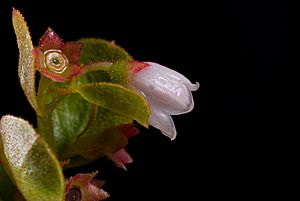Dwarf huckleberry facts for kids
Quick facts for kids Dwarf huckleberry |
|
|---|---|
 |
|
| Conservation status | |
| Scientific classification | |
| Genus: |
Gaylussacia
|
| Species: |
dumosa
|
| Synonyms | |
|
|
The Dwarf Huckleberry (Gaylussacia dumosa) is a cool flowering plant. It belongs to the heath family, just like blueberries! People also call it the bush huckleberry or gopherberry. This plant grows naturally across eastern North America. You can find it from Newfoundland all the way down to Louisiana and Florida. It likes to live near the coast and in mountain areas.
Contents
What is Dwarf Huckleberry?
The dwarf huckleberry is a type of shrub. It grows branches right from its base. The plant stands upright and can reach about 75 centimeters (30 inches) tall. It grows from a special underground stem called a rhizome.
Leaves and Flowers
Young branches of the dwarf huckleberry are covered in curly hairs. Its leaves are oval-shaped and feel a bit leathery. They also have tiny glands. These leaves fall off the plant each year, so they are called deciduous.
The plant produces bell-shaped flowers. These flowers grow in a cluster called a raceme. After the flowers, small fruits appear.
The Fruit
The fruit of the dwarf huckleberry is a berry. These berries are a tasty treat for many animals.
How Dwarf Huckleberry Grows
This plant can grow in different types of places. It likes both dry and moist areas. You can find it in forests and pine barrens. It also grows in pine flatwoods, bogs, and bays.
Plant Neighbors
The dwarf huckleberry often grows near other interesting plants. Some of its neighbors include:
- Eastern red cedar (Juniperus virginiana)
- Tamarack (Larix laricina)
- Redbay (Persea borbonia)
- Sweetbay (Magnolia virginiana)
- Flowering dogwood (Cornus florida)
- Dangleberry (Gaylussacia frondosa)
- Yaupon (Ilex vomitoria)
- Fetterbush (Leucothoe racemosa)
- Different kinds of blueberry plants (Vaccinium species)
Reproduction and Life Cycle
The dwarf huckleberry reproduces in two main ways. It can grow from seeds. It also sprouts new plants from its underground rhizome. This means new plants can pop up from the existing root system.
An interesting fact about this plant is how it handles wildfires. After a wildfire, the dwarf huckleberry can quickly sprout new growth from its rhizome. This helps it recover and thrive in areas that experience fires.


